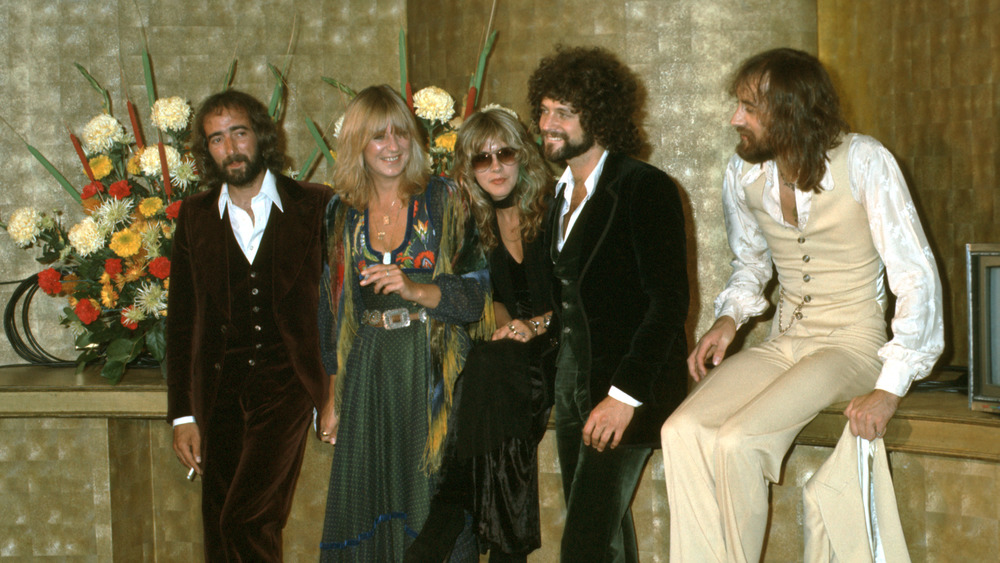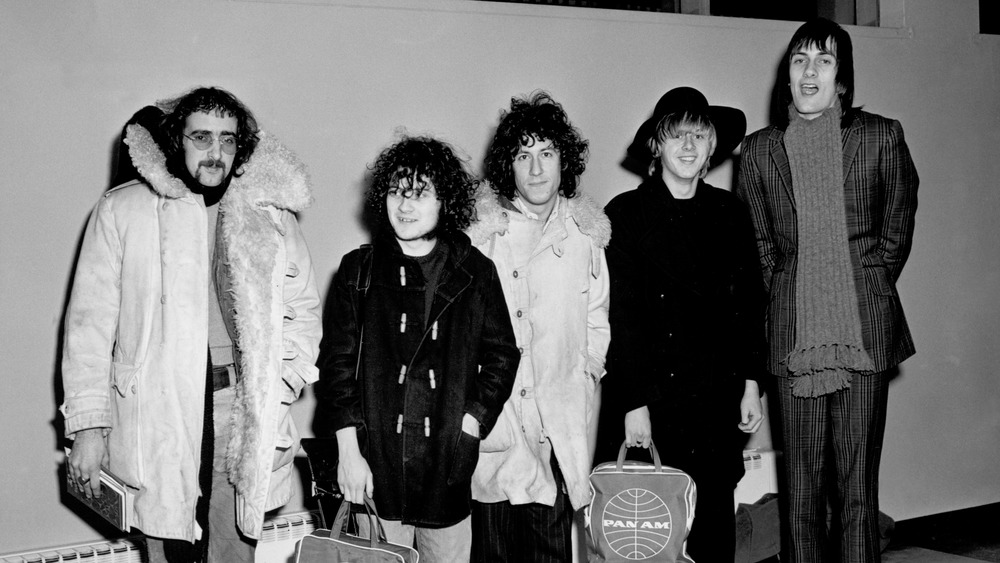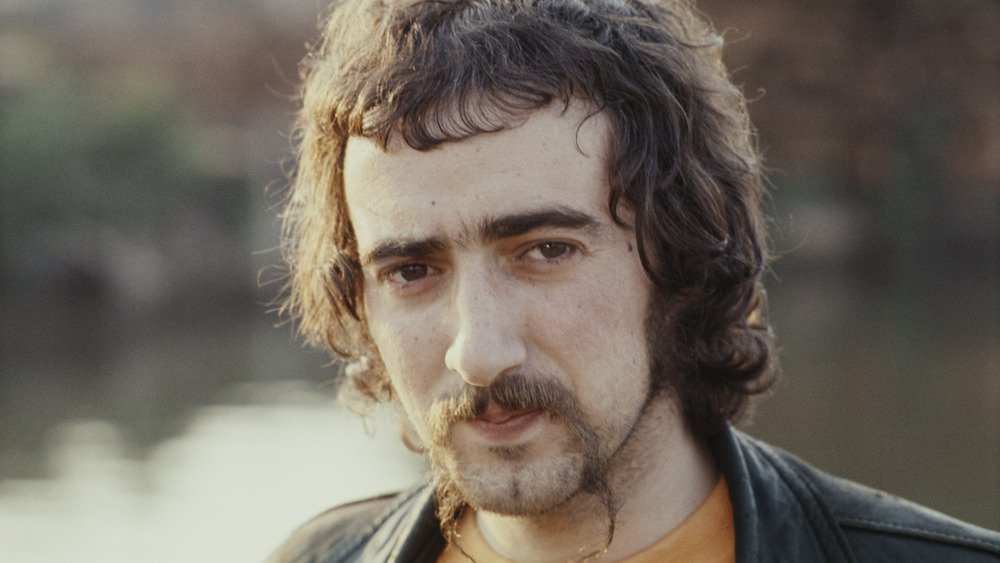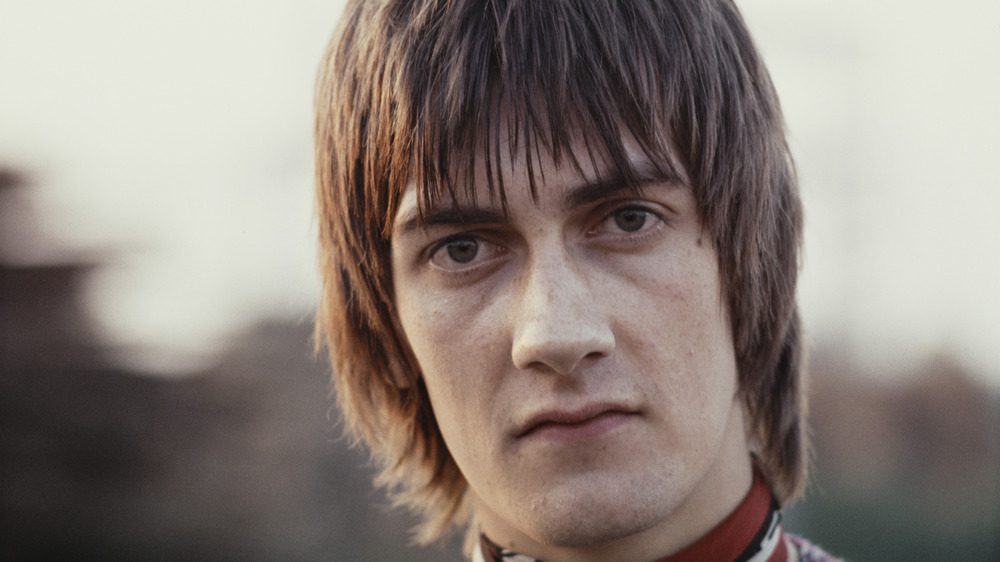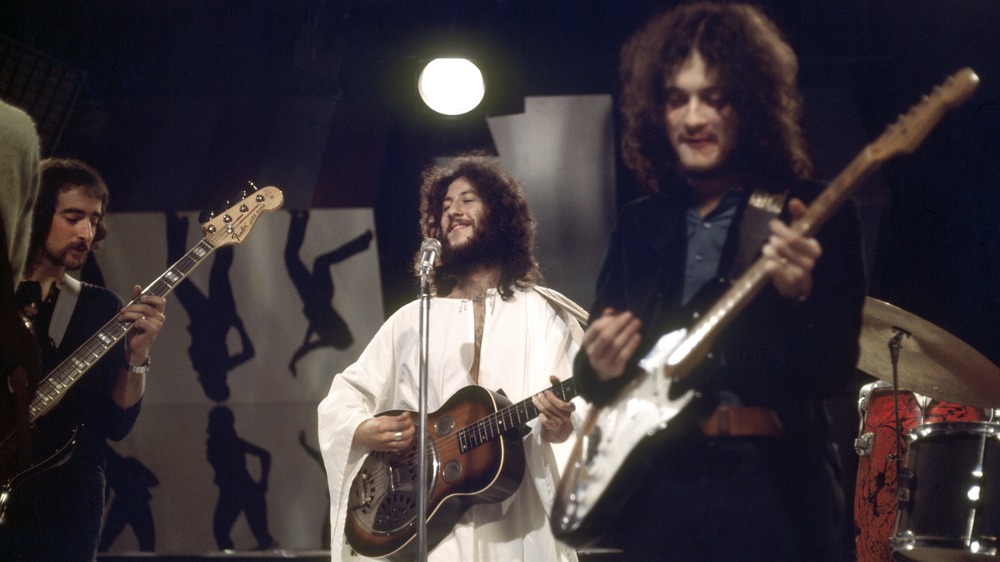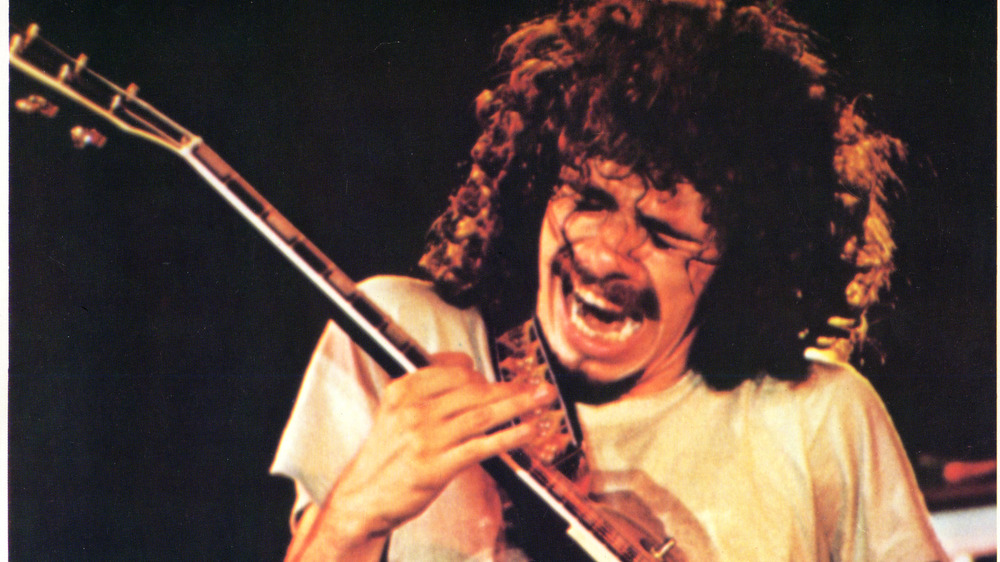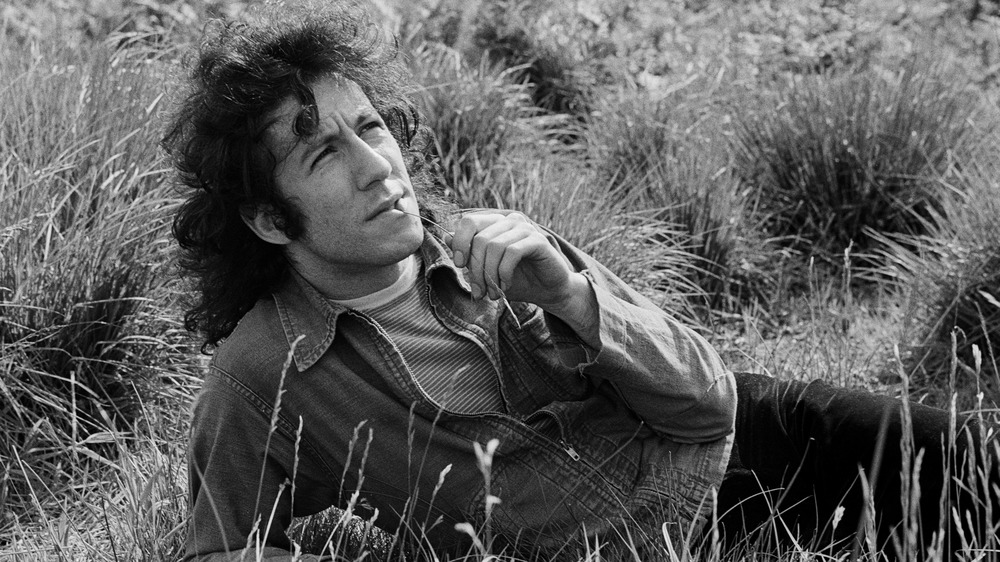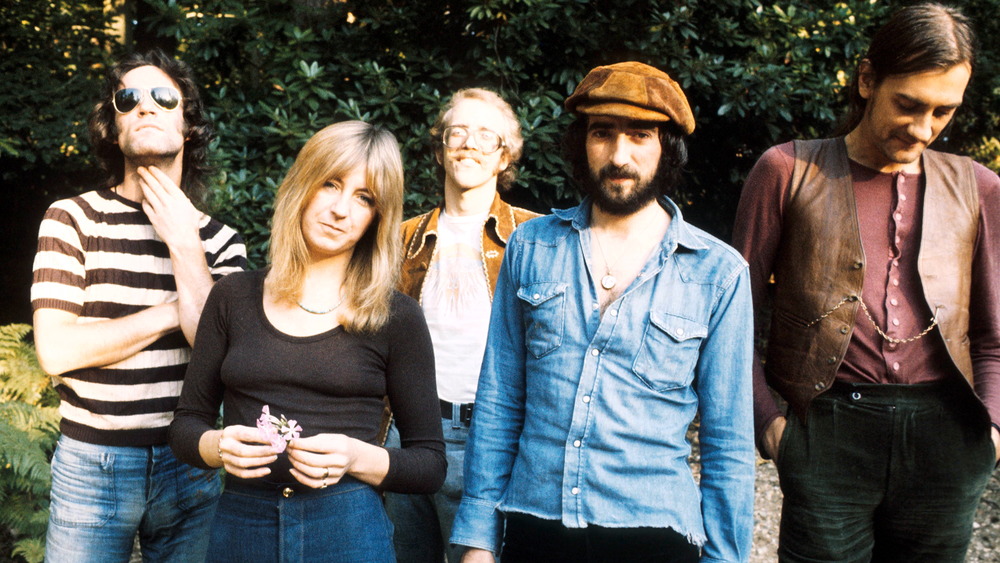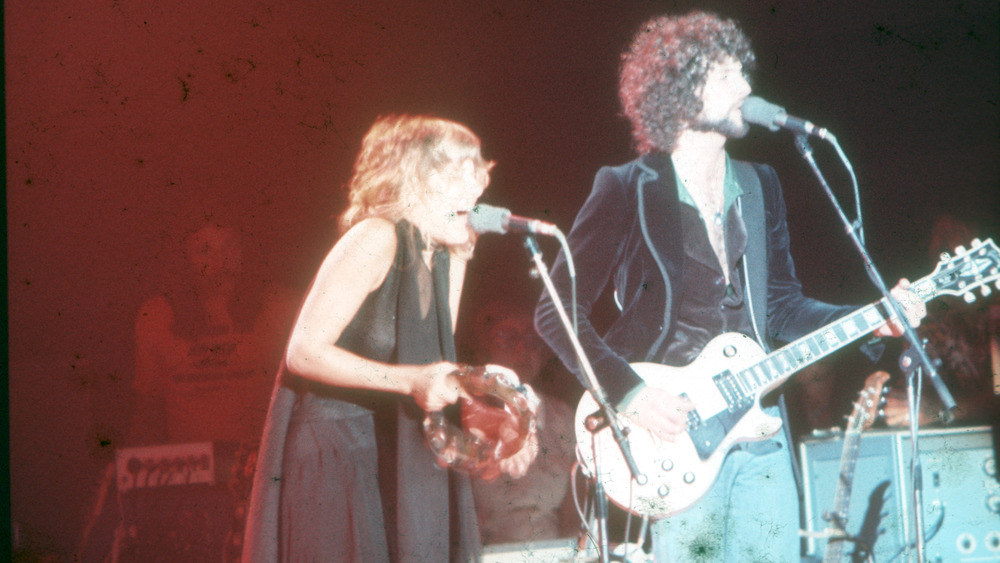False Things You Believe About Fleetwood Mac
According to Business Insider, only 20 artists have sold more album units than Fleetwood Mac. The group has sold more units than legendary bands and artists like Bob Dylan, Queen, Britney Spears, and Santana. And when one looks at their catalog of music, as well as the talented musicians who have performed under the Fleetwood Mac name, this is not surprising. From their origins in the late 1960s to their commercial peak about a decade later, Fleetwood Mac's name and albums have found a place in the minds and ears of generations of fans.
With all their success throughout their decades together, it is easy to understand why a few myths having to do with the band have spawned up. The Mandela Effect surrounds the band as much as Lindsey Buckingham's guitar solos and Stevie Nicks' black-veiled dresses. It is easy for fans to not realize the band had a history prior to Nicks and Buckingham, or that their first albums sounded closer to Jimi Hendrix than to Crosby, Stills, Nash, and Young.
While their sound and band members throughout the decades have changed, the truth of the band's founding, peaks and valleys, and influence on the music industry and on their contemporaries are as real as their gold and diamond records. Either led by a trio of British bluesmen or a California singer/songwriter duo, Fleetwood Mac is a legend in the music industry. Here are the false things you believe about Fleetwood Mac.
Fleetwood Mac was always a pop-rock group
When the average fan thinks of Fleetwood Mac, the first songs that come to mind are soft and pop-rock hits such as "Rhiannon" or "Dreams." The California singer/songwriter dynamic and arena rock sound that dominated charts in the late 1960s and throughout the 1970s had a large influence on the group. Still, Fleetwood Mac was not a California pop-rock band. They were originally, as told by Ultimate Classic Rock, a British blues band that sought to pay tribute to their American blues influences.
The original Fleetwood Mac lineup was born out of the remnants of another band, John Mayall's Bluesbreakers. Mayall had been a staple in British electric blues since the 1950s, earning him the honorific title of "The Godfather of British Blues." According to Mayall's website, John McVie, Mick Fleetwood, and Peter Green were not the only musicians who got their start with Mayall before achieving stardom. Eric Clapton, Mick Taylor of the Rolling Stones, and Andy Fraser of Free all passed through Mayall's Bluesbreakers before moving on to success in other bands and as solo artists.
Guitar World reports that Green was selected by Mayall to replace Clapton, who departed to form the supergroup Cream. A tough task as Clapton was literally nicknamed "God!" Still, Green's tenure in the band was successful enough to make him a British legend of his own right by the time he left the band to form Fleetwood Mac with McVie, Fleetwood, and slide guitarist Jeremy Spencer.
John McVie was the original bassist
It might come as a shock that, while Fleetwood Mac has had a revolving door of members, John McVie was part of that revolving door. This despite the fact that the band is partially named after him! Still, for the band's first three months of its existence, another man played bass while McVie continued his work with John Mayall's Bluesbreakers (which Peter Green and Mick Fleetwood were formerly a part of). According to the Guardian, the band made their debut at the 1967 National Jazz and Blues Festival with Bob Brunning as the bassist.
According to AllMusic, while Green, Fleetwood, and McVie were all members of John Mayall's Bluesbreakers, McVie had been a member longer than the two and had looked to Mayall as a mentor. He did not want to leave to form a band that he doubted could stand out against other British blues bands.
So he stayed with the Bluesbreakers, and Green and Fleetwood brought on Brunning, a college student who was a member of the group Five's Company, according to Blues Gr. Despite understanding that McVie would become the group's bassist if he left Mayall, Brunning left school and took the job. McVie eventually left the Bluesbreakers, and Brunning's stint in Fleetwood Mac was over, appearing in only one song, "Long Grey Mare," that made its way onto their debut album. Fleetwood Mac.net says that Brunning played in a number of bands afterwards, became an educator, and ran a blues club.
Mick Fleetwood was always the leader
Despite the fact that their names form the name of the band, drummer Mick Fleetwood and bassist John McVie were not seen as the band's leaders in the early days. Seeing that Fleetwood was part of the original lineup and eventually became the de facto leader in later years, it would make sense that he would be the leader. However, the leadership role fell on Peter Green. According to the Independent, Green's command of the band was so great, after their first album, the band was known as Peter Green's Fleetwood Mac.
Green was far from a dictator in terms of his leadership. A rather humble man, Green did not enjoy being considered a "guitar hero" or "guitar god." According to NPR, Green told guitarist Jeremy Spencer that he had planned to one day leave the band and wanted to give the bandmates something. "They're my friends, what are they going to have? I'm going to leave them with the name."
Hence, Fleetwood Mac was born from Green combining the names of Mick Fleetwood and John McVie. Green also pushed back at the label's decision to name their self-titled debut, Peter Green's Fleetwood Mac, and it was released with his name removed. When discussing his friend and bandmate, Fleetwood had this to say to the Irish Times. "Peter could have been the stereotypical superstar guitar player and control freak but that wasn't his style... Peter Green is the reason there's a Fleetwood Mac."
Fleetwood Mac did not have early success
British blues in the 1960s was a gold mine for hit singles, and while the Stevie Nicks/Lindsay Buckingham lineup of Fleetwood Mac had more commercial and critical success, the band's early blues days had their fair share of chart success. According to Official Charts, while Peter Green was a member of Fleetwood Mac, the band had all four of their albums reach the top 20 and seven songs to hit the top 40 on the United Kingdom singles charts, including a No. 1 hit with the instrumental "Albatross" and their songs "Man of the World" and "Oh Well" peaking at No. 2 on the singles chart.
After their self-titled debut failed to generate a single hit (though the album peaked at No. 4), the band expanded their sound from strictly blues and added influences from different musical elements. Two of their three hits from 1968, "Black Magic Woman" and "Albatross," reflect these changes. Ultimate Classic Rock says that their second album, Mr. Wonderful, marked their change, becoming a band that used the blues as a musical starting point instead of being a strict blues band.
By their third studio album, the last album with Green, the band had continued this musical evolution to a pop/rock sound with the blues as a base, according to Pop Matters.
Green's lyricism on the album was as strong as it had been throughout his tenure. While the album marked the end of his era with the band, Green left on a strong note.
Fleetwood Mac wrote one of Santana's most famous songs
According to Billboard, Santana's version of "Black Magic Woman" became the band's first song to crack the top 40, peaking at No. 4 in the first week of 1971. The song has become as associated with Carlos Santana and his band like "Proud Mary" has been associated with Tina Turner and "Twist and Shout" with The Beatles. And in all three instances, these songs were originally written and released by another, legendary artist and became more popular through covers.
According to Songfacts, frontman Carlos Santana was a big fan of Fleetwood Mac. Santana recalled in an interview how he would watch Peter Green and Fleetwood Mac anytime he had the chance and called them "the best blues band." Already a fan, it only made sense for Santana to cover Fleetwood Mac's biggest hit to that period.
I Love Classic Rock said that the influences of Santana's "Black Magic Woman" did not just come from Green. Their version also covered Hungarian guitarist Gabor Szabo's song "Gypsy Queen," mixing the two songs with the Latin rhythms Santana was famous for.
While Santana's version has become more remembered than the original, many other songs during Fleetwood Mac's early period have also been covered. According to Spin, Judas Priest covered "The Green Manalishi" on their 1979 LP, Hell Bent For Leather, and artists from Tom Petty to Haim to Jimmy Page have all covered "Oh Well."
Jeremy Spencer was forced into a cult
As the slide guitarist in Fleetwood Mac's first lineup and a talented vocalist, Jeremy Spencer had a large hand in the early success of the original lineup, making his disappearance, turning up in religious cult, and ultimate departure from the band shocking. According to All Music, hours before a show in Los Angeles, Spencer disappeared without a trace. Five days later, police discovered him as a new member of the Christian sect organization, the Children of God.
According to Crowdfund Insider, the Children of God organization was founded by David Berg. It has since been renamed The Family Internation or TFI and claims that its organization is, "an international Christian fellowship committed to sharing the message of God's love with people around the globe."
However, the organization has been referred to as a cult and has a long history of sexual abuse and child molestation allegations. Similar to Scientology, former members of the organization include some of the biggest names in Hollywood, such as actor Rose McGowan and the Phoenix family, CheatSheet reports. They did not speak lovingly about their times in the organization, as well as Christina Babin, who gave an interview on "Megyn Kelly TODAY" in 2018.
Spencer himself has been accused of multiple counts of child abuse while a member of the organization, which he remains to this day. Vintage News reports that Spencer spent most of his time in the organization touring, going a quarter-century between studio albums.
Peter Green never returned to Fleetwood Mac
In 1970, after releasing the band's third studio album, Then Play On, Peter Green's mental state was reaching its breaking point as the group was touring in Europe. Drugs, undiagnosed at the time schizophrenia, and according to Mick Fleetwood, a bad drug trip in Germany that he "never really came back from" led Green to leave the band he had formed. Like Pink Floyd's Syd Barrett, Green would be wrapped in his mental disease for a long time. However, unlike Barrett, whose talent was decimated by the disease, Green was eventually able to break from his demons, return to music, and even collaborated with his old band from time to time.
According to Fleetwood Mac Fandom, only three years after Green left the band, he returned for a single song on their 1973 album, Penguin. Green's contribution to the song, "Night Watch," went uncredited. On Mick Fleetwood's 1981 solo album, The Visitor, Green re-recorded his classic song, "Rattlesnake Shake," which was originally recorded by the band on their 1969 album, Then Play On.
On one of the band's most successful albums, Tusk, Green played guitar on the song "Brown Eyes." In a 1999 interview with Penguin, Green said he did not remember recording the song and blamed it on his declining health during the time period. The beginning of the 1970s and Green's departure marked the end of the original Fleetwood Mac and the beginning of the most successful version of Fleetwood Mac.
Fleetwood Mac did not release albums between Green's departure and Nicks/Buckingham inclusion
The beginning of the 1970s and Peter Green's departure marked the end of the original Fleetwood Mac and the beginning of the most successful version of the band, after a few years of irrelevance. With Green and Jeremy Spencer, Fleetwood Mac was a successful blues band. With Stevie Nicks and Lindsey Buckingham, the band reached even greater heights commercially and critically as an arena rock band. Between the two distinct versions of the band, there was a half-decade period that most fans have forgotten.
Not only did the remainder of the band release albums during this limbo state, but they released more studio albums (six) than they did with Green (four) or with the classic lineup of John and Christine McVie, Mick Fleetwood, Nicks, and Buckingham (five). In their first post-Green album, Kiln House, the group returned to their roots in classic 1950s rock, similar to that of Buddy Holly and Gene Vincent, as told by Ultimate Classic Rock. The album sold poorly, and Spencer would leave soon after.
Their next album, Future Games, saw keyboardist and singer, Christine McVie, officially became a member of the group. Wife of John McVie, Christine had contributed to Fleetwood Mac since their second album. Again, the album failed to capture the audience and was panned by critics. Their next four albums were more of the same until Nicks and Buckingham joined for their 1975 self-titled work
Stevie Nicks and Lindsey Buckingham were married
While Fleetwood Mac was known for the relationships in the band between members, only John and Christine McVie were married bandmates. Stevie Nicks and Lindsey Buckingham, though a talented duo before joining the group and described by Far Out Magazine as "an inseparable duo ever since they first met," never actually married. The pair first met at Menlo-Atherton High School when Nicks came across Buckingham covering The Mamas and the Papas' hit song, "California Dreamin," at which point Nicks joined in the harmonies.
According to Honey Nine, Buckingham called Nicks two years after their initial meeting, asking her to join his band, Fritz. By 1973, Fritz had disbanded, and Nicks and Buckingham released their first album as a duo, and as a couple. Two years after that album, the duo got the opportunity of a lifetime when they joined an established band in Fleetwood Mac. Bustle interviewed Nicks about her life at that time for their profile on celebrities when they were 28 years old, she said, "I probably have the best 28 story of anybody that you will interview."
However, the relationship by this time was deteriorating. Nicks said that Buckingham was very controlling and distrustful of her. By the time of their second album with Fleetwood Mac, Rumours, the pair were writing and recording songs giving their versions of their breakup. Nicks said this about her relationship with Buckingham, "He and I were about as compatible as a boa constrictor and a rat."
Tom Petty and Stevie Nicks dated
Whoever created the ridiculous phrase, "men and women cannot just be friends" never met Tom Petty and Stevie Nicks. For about four decades, the pair of singer/songwriters had a close relationship that spawned a number of collaborations. However, despite their closeness, the pair's relationship stayed platonic. According to Biography, the relationship was one-sided originally. In the late 1970s, Nicks was at her zenith with Fleetwood Mac when she first heard Petty's music as the leader of Tom Petty and the Heartbreakers. Nicks was so intoxicated by the music, she started modeling her own music after Petty and went to extreme lengths to get in contact with the artist.
In Petty's autobiography, Runnin' Down A Dream, he declined Nicks' request to join The Heartbreakers. Petty and the Heartbreakers all played music on Nicks' first solo album, Bella Donna, which was produced by Nicks' boyfriend and Petty's producer, Jimmy Iovine. All but one song on the album was written by Nicks. Only the hit single, "Stop Draggin' My Heart," was written by Petty. According to Ultimate Classic Rock, Petty had given Nicks another song to perform, "Insider," which she returned because she saw he loved the track and requested he write her another song.
Petty and Nicks maintained a close friendship from then till his 2017 death. Before he passed while the pair was on tour, Petty gave into Nicks' old request and made her an "honorary Heartbreaker," according to Louder Sounder.
The members get along today
Time heals all wounds. From Mick Jagger and Keith Richards to Dr. Dre and Ice Cube, bandmates who feuded eventually kiss and make up after a while. In other cases, the death of one feuding party led the other to regret the previous bitterness, as shown between John Lennon and George Harrison. Well, Fleetwood Mac's Lindsey Buckingham has been fighting with members on his worst days, and on his best days, there has been tension between himself and other members, especially with his ex-partner Stevie Nicks. While John and Christine McVie have been able to overcome their messy divorce to continue performing to this day, the same cannot be said about Nicks and Buckingham. According to Newsweek, Buckingham was kicked out of the band in 2018. Buckingham said the boot came from Nicks, who gave the band an ultimatum to pick between herself or Buckingham.
Buckingham responded to the departure by suing his former band, as told by Rolling Stone. The two sides eventually reached an undisclosed settlement, and Buckingham was replaced with Mike Campbell, guitarist of the Heartbreakers, and Neil Finn of Crowded House. Any hope for another reunion seems to be quashed, as Mick Fleetwood has told NME that Buckingham would never reunite with the band again. In July 2020, Peter Green died in his sleep at 73 years old. Regardless of who has played in the band, Fleetwood Mac has cemented their place in the annals of popular music through decades of work.
